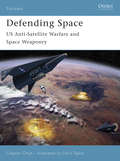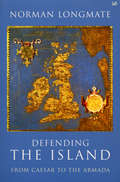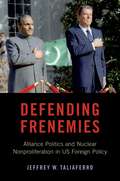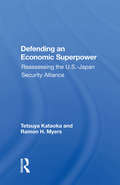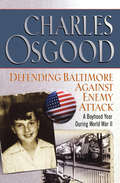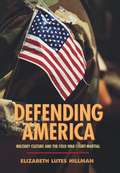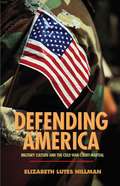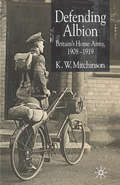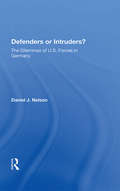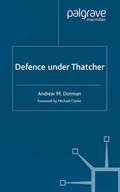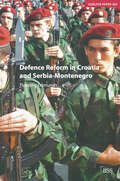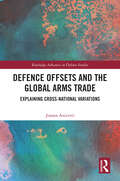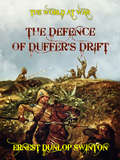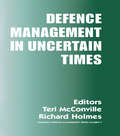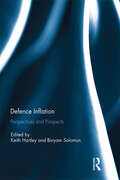- Table View
- List View
Defending Space: US Anti-Satellite Warfare and Space Weaponry (Fortress)
by Clayton Chun Chris TaylorThe United States has been developing space for many years, and satellites provide the US Military with an unparaleled advantage over its adversaries. Constellations of both military and civilian satellites provide protection and support for military operations; deliver ballistic missile early warning; supply reliable, secure and jam-proof communications; gather audio-visual intelligence; predict weather patterns; guide navigation; and deliver guided-weapons targeting, as well as a host of other missions. This book explores the design, development and usage of US military space systems, as well past and future threats to the systems. The current relevance of this topic to the international community as a whole is key, as space becomes the next, if only virtual, theater of warfare.
Defending Space: US Anti-Satellite Warfare and Space Weaponry (Fortress #53)
by Clayton Chun Chris TaylorThe United States has been developing space for many years, and satellites provide the US Military with an unparaleled advantage over its adversaries. Constellations of both military and civilian satellites provide protection and support for military operations; deliver ballistic missile early warning; supply reliable, secure and jam-proof communications; gather audio-visual intelligence; predict weather patterns; guide navigation; and deliver guided-weapons targeting, as well as a host of other missions. This book explores the design, development and usage of US military space systems, as well past and future threats to the systems. The current relevance of this topic to the international community as a whole is key, as space becomes the next, if only virtual, theater of warfare.
Defending The Island: From Caesar to the Armada
by Norman LongmateIn a brilliantly imaginative blend of military, social and diplomatic history, Norman Longmate retells our island story from the perspective of its defenders, in a narrative which stretches from the Celtic tribes who unsuccessfully fought against Ceasar to the great seabourne defence against the Armada of Philip of Spain. He has gone back to the original sources and investigated the original battlegrounds and weak spots in Britain's defences. But the real strength of his book is its seamless narrative of history, which uncovers the truth behind the legends. A mass of solidly researched fact, not readily found elsewhere, is seasoned with lively, humorous and occassionally gruesome anecdote. The result, providing at once an invaluable sourcebook for the specialist and an enthralling narrative for the general reader, is by far the most comprehensive and accessible history of England versus invasion ever published.
Defending Frenemies: Alliances, Politics, and Nuclear Nonproliferation in US Foreign Policy
by Jeffrey W. TaliaferroThe United States maintains defense ties with as many as 60 countries, which not only enables its armed forces to maintain command globally and to project its force widely, but also enables its government to exert leverage over allies' foreign policies and military strategies. In Defending Frenemies, Jeffrey W. Taliaferro presents a historical and comparative analysis of how successive US presidential administrations have employed inducements and coercive diplomacy toward Israel, Pakistan, South Korea, and Taiwan over nuclear proliferation. Taliaferro shows that the ultimate goals in each administration, from John F. Kennedy to George H. W. Bush, have been to contain the Soviet Union's influence in the Middle East and South Asia and to enlist China as an ally of convenience against the Soviets in East Asia. Policymakers' inclinations to pursue either accommodative strategies or coercive nonproliferation strategies toward allies have therefore been directly linked to these primary objectives. Defending Frenemies is sharp examination of how regional power dynamics and US domestic politics have shaped the nonproliferation strategies the US has pursued toward vulnerable and often obstreperous allies.
Defending Frenemies: Alliances, Politics, and Nuclear Nonproliferation in US Foreign Policy
by Jeffrey W. TaliaferroThe United States maintains defense ties with as many as 60 countries, which not only enables its armed forces to maintain command globally and to project its force widely, but also enables its government to exert leverage over allies' foreign policies and military strategies. In Defending Frenemies, Jeffrey W. Taliaferro presents a historical and comparative analysis of how successive US presidential administrations have employed inducements and coercive diplomacy toward Israel, Pakistan, South Korea, and Taiwan over nuclear proliferation. Taliaferro shows that the ultimate goals in each administration, from John F. Kennedy to George H. W. Bush, have been to contain the Soviet Union's influence in the Middle East and South Asia and to enlist China as an ally of convenience against the Soviets in East Asia. Policymakers' inclinations to pursue either accommodative strategies or coercive nonproliferation strategies toward allies have therefore been directly linked to these primary objectives. Defending Frenemies is sharp examination of how regional power dynamics and US domestic politics have shaped the nonproliferation strategies the US has pursued toward vulnerable and often obstreperous allies.
Defending An Economic Superpower: Reassessing The U.s.-japan Security Alliance
by Tetsuya KataokaThis book describes the reassessment of the U.S.-Japan security relationship to determine how Japan can do more for its defense, reduce America's spending for Japan's and Asia's security, yet preserve the peace in that region. It raises six questions about the relationship and tries to answer them.
Defending An Economic Superpower: Reassessing The U.s.-japan Security Alliance
by Tetsuya KataokaThis book describes the reassessment of the U.S.-Japan security relationship to determine how Japan can do more for its defense, reduce America's spending for Japan's and Asia's security, yet preserve the peace in that region. It raises six questions about the relationship and tries to answer them.
Defending Baltimore Against Enemy Attack: A Boyhood Year During World War II
by Charles OsgoodFrom beloved broadcaster Charles Osgood, a poignant memoir about one unforgettable childhood year during World War II. Defending Baltimore Against Enemy Attack is a gloriously funny and nostalgic slice of American life and a moving look at World War II from the perspective of a child far away from the fighting, but very conscious of the reverberations. With a sharp eye for details, Osgood captures the texture of life in a bygone era.
Defending Baltimore Against Enemy Attack: A Boyhood Year During World War II
by Charles OsgoodFrom beloved broadcaster Charles Osgood, a poignant memoir about one unforgettable childhood year during World War II.Defending Baltimore Against Enemy Attack is a gloriously funny and nostalgic slice of American life and a moving look at World War II from the perspective of a child far away from the fighting, but very conscious of the reverberations. With a sharp eye for details, Osgood captures the texture of life in a bygone era.
Defending America: Military Culture and the Cold War Court-Martial (PDF)
by Elizabeth Lutes HillmanFrom going AWOL to collaborating with communists, assaulting fellow servicemen to marrying without permission, military crime during the Cold War offers a telling glimpse into a military undergoing a demographic and legal transformation. The post-World War II American military, newly permanent, populated by draftees as well as volunteers, and asked to fight communism around the world, was also the subject of a major criminal justice reform. By examining the Cold War court-martial, Defending America opens a new window on conflicts that divided America at the time, such as the competing demands of work and family and the tension between individual rights and social conformity. Using military justice records, Elizabeth Lutes Hillman demonstrates the criminal consequences of the military's violent mission, ideological goals, fear of homosexuality, and attitude toward racial, gender, and class difference. The records also show that only the most inept, unfortunate, and impolitic of misbehaving service members were likely to be prosecuted. Young, poor, low-ranking, and nonwhite servicemen bore a disproportionate burden in the military's enforcement of crime, and gay men and lesbians paid the price for the armed forces' official hostility toward homosexuality. While the U.S. military fought to defend the Constitution, the Cold War court-martial punished those who wavered from accepted political convictions, sexual behavior, and social conventions, threatening the very rights of due process and free expression the Constitution promised.
Defending America: Military Culture and the Cold War Court-Martial (Politics and Society in Modern America #140)
by Elizabeth Lutes HillmanFrom going AWOL to collaborating with communists, assaulting fellow servicemen to marrying without permission, military crime during the Cold War offers a telling glimpse into a military undergoing a demographic and legal transformation. The post-World War II American military, newly permanent, populated by draftees as well as volunteers, and asked to fight communism around the world, was also the subject of a major criminal justice reform. By examining the Cold War court-martial, Defending America opens a new window on conflicts that divided America at the time, such as the competing demands of work and family and the tension between individual rights and social conformity. Using military justice records, Elizabeth Lutes Hillman demonstrates the criminal consequences of the military's violent mission, ideological goals, fear of homosexuality, and attitude toward racial, gender, and class difference. The records also show that only the most inept, unfortunate, and impolitic of misbehaving service members were likely to be prosecuted. Young, poor, low-ranking, and nonwhite servicemen bore a disproportionate burden in the military's enforcement of crime, and gay men and lesbians paid the price for the armed forces' official hostility toward homosexuality. While the U.S. military fought to defend the Constitution, the Cold War court-martial punished those who wavered from accepted political convictions, sexual behavior, and social conventions, threatening the very rights of due process and free expression the Constitution promised.
Defending America: Military Culture and the Cold War Court-Martial (Politics and Society in Modern America #140)
by Elizabeth Lutes HillmanFrom going AWOL to collaborating with communists, assaulting fellow servicemen to marrying without permission, military crime during the Cold War offers a telling glimpse into a military undergoing a demographic and legal transformation. The post-World War II American military, newly permanent, populated by draftees as well as volunteers, and asked to fight communism around the world, was also the subject of a major criminal justice reform. By examining the Cold War court-martial, Defending America opens a new window on conflicts that divided America at the time, such as the competing demands of work and family and the tension between individual rights and social conformity. Using military justice records, Elizabeth Lutes Hillman demonstrates the criminal consequences of the military's violent mission, ideological goals, fear of homosexuality, and attitude toward racial, gender, and class difference. The records also show that only the most inept, unfortunate, and impolitic of misbehaving service members were likely to be prosecuted. Young, poor, low-ranking, and nonwhite servicemen bore a disproportionate burden in the military's enforcement of crime, and gay men and lesbians paid the price for the armed forces' official hostility toward homosexuality. While the U.S. military fought to defend the Constitution, the Cold War court-martial punished those who wavered from accepted political convictions, sexual behavior, and social conventions, threatening the very rights of due process and free expression the Constitution promised.
Defending Albion: Britain's Home Army 1908-1919 (Studies in Military and Strategic History)
by K. W. MitchinsonDefending Albion is the first published study of Britain's response to the threat of invasion from across the North Sea in the first two decades of the Twentieth Century. It examines the emergency schemes designed to confront an enemy landing and the problems associated with raising and maintaining the often derided Territorial Force. It also explores the long-neglected military and political difficulties posed by the spontaneous and largely unwanted appearance of the 'Dad's Army' of the Great War, the Volunteer Force.
Defenders Or Intruders?: The Dilemmas Of U.s. Forces In Germany
by Daniel J. NelsonFollowing Dr. Nelson’s A History of U.S. Military Forces in Germany; this book examines contemporary socioeconomic problems created by the stationing of U.S. troops in West Germany (FRG). The issues are magnified by the FRG’s strategic importance to the United States, the large number of U.S. troops stationed in the FRG, and the length of time they
Defenders Or Intruders?: The Dilemmas Of U.s. Forces In Germany
by Daniel J. NelsonFollowing Dr. Nelson’s A History of U.S. Military Forces in Germany; this book examines contemporary socioeconomic problems created by the stationing of U.S. troops in West Germany (FRG). The issues are magnified by the FRG’s strategic importance to the United States, the large number of U.S. troops stationed in the FRG, and the length of time they
Defence Under Thatcher (Southampton Studies in International Policy)
by A. DormanDrawing upon a wide range of interviews with many of the key actors, Andrew Dorman examines how defence policy was formulated and implemented during the premiership of Margaret Thatcher. This period witnessed major transformations in international and domestic politics, with defence emerging from its traditional postwar position of relative insignificance to become one of the key issues at the 1983 and 1987 general elections. Dorman provides a new understanding of policymaking by analysing defence policy in terms of three constituent parts: declaratory policy; military strategy and procurement policy.
Defence Reform in Croatia and Serbia--Montenegro (Adelphi series)
by Timothy EdmundsThis book examines defence reform in Croatia and Serbia-Montenegro since 2000, focussing particularly on the institution and consolidation of democratic and civilian control of the armed forces, the reform of conflict-era forces structures, and the influence of the West including defence assistance and political conditionality.
Defence Reform in Croatia and Serbia--Montenegro (Adelphi series)
by Timothy EdmundsThis book examines defence reform in Croatia and Serbia-Montenegro since 2000, focussing particularly on the institution and consolidation of democratic and civilian control of the armed forces, the reform of conflict-era forces structures, and the influence of the West including defence assistance and political conditionality.
Defence Offsets and the Global Arms Trade: Explaining Cross-National Variations (Routledge Advances in Defence Studies)
by Jonata AnicettiThis book offers the first comprehensive study of defence offsets and its economic, security, political and theoretical implications.Originating in the second half of the 19th century, defence offsets - additional economic, industrial and technological benefits to states for buying foreign weapons - have since been a key feature of the global arms trade and defence industry. And yet, offsets are an under-researched and under-theorised phenomenon. This book fills this gap in the literature by offering the first general theory of defence offsets, as well as the first systematic analysis of the offset phenomenon. By building on the insights of scholars of defence economics and drawing from the International Relations liberal paradigm, as well as reviving and adapting Robert Putnam’s two-level game framework, the book proposes a liberal-rationalist theory of defence offsets. It then proves the worth of such a theory through Qualitative Comparative Analysis (QCA) of fifty-four fighter aircraft transfers from 1992 to 2021 inclusive, and three in-depth case studies addressing offsets negotiated and agreed to as part of fighter aircraft competitions in Brazil, India, and South Korea.This book will be of interest to students of defence studies, defence economics, security studies and international relations.
Defence Offsets and the Global Arms Trade: Explaining Cross-National Variations (Routledge Advances in Defence Studies)
by Jonata AnicettiThis book offers the first comprehensive study of defence offsets and its economic, security, political and theoretical implications.Originating in the second half of the 19th century, defence offsets - additional economic, industrial and technological benefits to states for buying foreign weapons - have since been a key feature of the global arms trade and defence industry. And yet, offsets are an under-researched and under-theorised phenomenon. This book fills this gap in the literature by offering the first general theory of defence offsets, as well as the first systematic analysis of the offset phenomenon. By building on the insights of scholars of defence economics and drawing from the International Relations liberal paradigm, as well as reviving and adapting Robert Putnam’s two-level game framework, the book proposes a liberal-rationalist theory of defence offsets. It then proves the worth of such a theory through Qualitative Comparative Analysis (QCA) of fifty-four fighter aircraft transfers from 1992 to 2021 inclusive, and three in-depth case studies addressing offsets negotiated and agreed to as part of fighter aircraft competitions in Brazil, India, and South Korea.This book will be of interest to students of defence studies, defence economics, security studies and international relations.
The Defence of Duffer's Drift (The World At War)
by Ernest Swinton"The Defence of Duffers Drift" is a fictional account of a young, inexperienced British officer, who is tasked with holding a river crossing with 50 troops against a larger enemy force. His initial failures and eventual victory serve as an entertaining and instructive vehicle to convey the principles of small unit tactics. Because it deals with principles, this definitive work has endured to this day and is still on some of the required reading lists of the U.S. Army and Marine Corps. (Goodreads)
Defence Management in Uncertain Times
by Teri McConville Richard HolmesFrom the impact of the attacks on New York and Washington in 2001, to the problems of military uncertainty and the role of women in combat, this collection of essays explores the changing face of militarism from the perspective of defence management experts.
Defence Management in Uncertain Times
by Teri McConville Richard HolmesFrom the impact of the attacks on New York and Washington in 2001, to the problems of military uncertainty and the role of women in combat, this collection of essays explores the changing face of militarism from the perspective of defence management experts.
Defence Inflation: Perspectives and Prospects
by Keith Hartley Binyam SolomonDefence inflation is a recurring factor in determining defence spending. It is widely reported in official government publications and in the trade press, but remains relatively neglected by defence and peace economists. In this book, international contributors from Finland, Norway, Sweden, the UK and the USA distinguish between defence inflation and cost escalation, and identify the causes of both. They use specific case studies to address a wide variety of theoretical and empirical issues and key questions, including the following: Does defence inflation affect all countries? What are its effects? Why does it occur? How (if at all) can defence inflation be controlled?While most industry and trade press devote considerable ink and space to the discussion of defence inflation, cost escalation, and their consequential impact on the purchasing dollars of the armed forces, economists have been relatively silent. This book aims to rectify this oversight through a multinational survey and analysis of the topic, while also identifying the opportunities for further theoretical and empirical research in the field. This book was originally published as a special issue of the journal Defence and Peace Economics.
Defence Inflation: Perspectives and Prospects
by Keith Hartley Binyam SolomonDefence inflation is a recurring factor in determining defence spending. It is widely reported in official government publications and in the trade press, but remains relatively neglected by defence and peace economists. In this book, international contributors from Finland, Norway, Sweden, the UK and the USA distinguish between defence inflation and cost escalation, and identify the causes of both. They use specific case studies to address a wide variety of theoretical and empirical issues and key questions, including the following: Does defence inflation affect all countries? What are its effects? Why does it occur? How (if at all) can defence inflation be controlled?While most industry and trade press devote considerable ink and space to the discussion of defence inflation, cost escalation, and their consequential impact on the purchasing dollars of the armed forces, economists have been relatively silent. This book aims to rectify this oversight through a multinational survey and analysis of the topic, while also identifying the opportunities for further theoretical and empirical research in the field. This book was originally published as a special issue of the journal Defence and Peace Economics.

